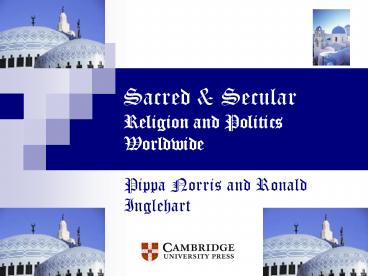Sacred & Secular Religion and Politics Worldwide Pippa - PowerPoint PPT Presentation
1 / 24
Title:
Sacred & Secular Religion and Politics Worldwide Pippa
Description:
Sacred & Secular Religion and Politics Worldwide Pippa Norris and Ronald Inglehart Structure Theories of secularization Religiosity & existential security Research ... – PowerPoint PPT presentation
Number of Views:32
Avg rating:3.0/5.0
Title: Sacred & Secular Religion and Politics Worldwide Pippa
1
Sacred SecularReligion and Politics Worldwide
- Pippa Norris and Ronald Inglehart
2
Structure
- Theories of secularization
- Religiosity existential security
- Research design
- Evidence
- Comparisons by type of society
- Failure of religious market theory in
post-Communist nations - Demographic patterns religiosity
- Conclusions
- Advanced industrial societies have become
steadily more secular during the last 50 years - Yet the world as a whole has more people with
traditional religious beliefs than ever before
3
Book Contents
4
ITheories of secularization
- Max Weber Enlightenment Rationality
- The loss of faith
- Emile Durkheim - Functionalism
- The loss of purpose
- Stark and Finke - Religious market theory
- After nearly three centuries of utterly failed
prophesies and misrepresentations of both present
and past, it seems time to carry the
secularization doctrine to the graveyard of
failed theories, and there to whisper requiescat
in pace Stark and Finke. 2000. Acts of Faith. - Public demand for religion is constant
- Supply-side competition among clergy energizes
religiosity - Religious participation explained by religious
pluralism and freedom of religion
5
Theory of secularization security
Demographic trends
H5
A1 Societies differ in levels of basic human
security
Religious values Eg Importance of
religion Importance of God
Religious Participation Eg Attend religious
services Daily prayer or meditation
Religious Political Activism Eg Member
religious groups Support religious party
H1
H4
H3
A2 Societies differ in their predominant
religious culture
Religious beliefs Eg Within each religion Moral
attitudes
H2
6
II. Research design?
7
World Values Survey 1981-2001
8
Classification of societies
SourcesType of predominant religion CIA World
Factbook Type of society HDI UNDP
9
Measures
10
III Evidence
11
Measures of religious participation
12
Note Religious participation Q185 Apart from
weddings, funerals and christenings, about how
often do you attend religious services these
days? More than once a week, once a week, once a
month, only on special hold days, once a year,
less often, never or practically never. The
proportion who attended Once a week or
more. Source World Values Survey (pooled
surveys, 1981-2001)
13
Religiosity by type of society
14
Religiosity Development
15
Trends in belief in God 1947-2001Ref Gallup
polls WVS
16
Trends in European church attendance,
1970-2000 Source Eurobarometer annual surveys
17
Religious participation by cohort
Agrarian
Industrial
Postindustrial
18
Religion economic inequality
19
Religiosity household income, postindustrial
societies Source WVS 1981-2001
20
Religion demographic trends
(Source World Bank 2003)
21
IV Conclusions
22
Conclusions
- Virtually all advanced industrial societies are
moving towards more secular orientations. - Yet the world as a whole now has more people with
traditional religious beliefs than ever before - The religion gap becomes increasingly salient on
the global agenda, yet the consequences for
international conflict remain unclear. - Further details/chapters www.pippanorris.com
23
Religiosity among postindustrial nations
24
Failure of market theoryPost-communist societies

